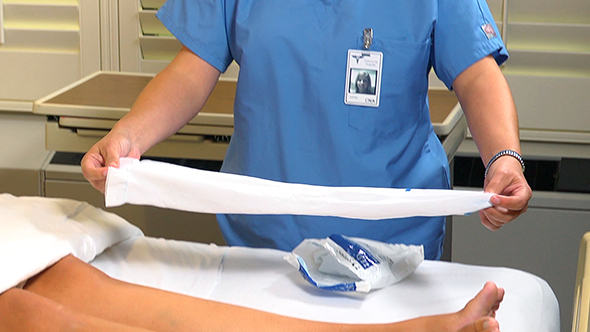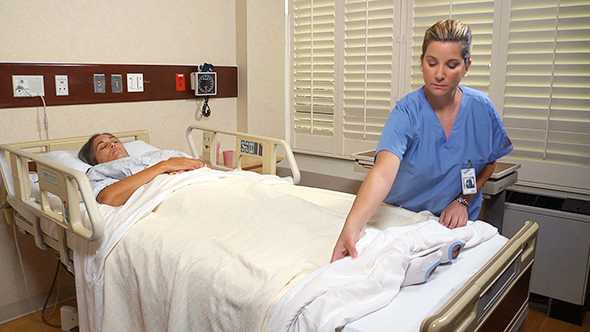Skin and Wound Care
Select a Skill:
- » Applying Elastic Stockings
- » Giving a Back Massage
- » Assisting with Pressure Ulcer Prevention and Care
- » Applying a Dry, Non-sterile Dressing
Take the Review Test:

Purpose

- Elastic stockings exert pressure on the veins. The pressure promotes venous blood return to the heart. The stockings help prevent blood clots (thrombi) in the leg veins. A blood clot is called a thrombus.
- If blood flow is sluggish, thrombi may form in the deep veins in the lower leg or thigh. A thrombus can break loose and travel through the bloodstream. It then becomes an embolus—a blood clot that travels through the vascular system until it lodges in a blood vessel. An embolus from a vein lodges in the lungs (pulmonary embolism). A pulmonary embolism can cause severe respiratory problems and death. Report chest pain or shortness of breath at once.
- Persons at risk for thrombi include those who:
- Have heart and circulatory disorders.
- Are on bedrest.
- Have had surgery.
- Are older.
- Are pregnant.
- Elastic stockings also are called AE (anti-embolic or anti-emboli) stockings. They also are called TED (thrombo-embolic disorder) hose.
- The person usually has two pairs of stockings. Wash one pair while the other pair is worn. Wash them by hand with a mild soap. Hang them to dry.
Equipment
Roll cursor over items to see labels. For the purposes of clearly depicting the equipment, a barrier is not shown in this photo. When providing care, a barrier should always be placed on the surface before placing the equipment.

Elastic stockings in the correct size and length
Delegation
- Follow delegation guidelines. Before applying elastic stockings, obtain this information from the nurse and care plan:
- What size to use—small, medium, large, or extra-large
- What length to use—thigh-high or knee-high
- When to remove them and for how long—usually every 8 hours for 30 minutes
- What observations to report and record
- When to report observations
- What patient or resident concerns to report at once
Preparation

- Observe quality-of-life measures.
- Review the information under Delegation and Safety and Comfort.
- Practice hand hygiene.
- Obtain elastic stockings in the correct size and length. Note the location of the toe opening.
- Identify the person. Check the ID bracelet against the assignment sheet. Also call the person by name.
- Provide for privacy.
- Raise the bed for body mechanics. Bed rails are up if used.
Safety

- Apply the stockings so the toe opening is over the top of the toes or under the toes. Follow the manufacturer’s instructions. Use the opening to check circulation, skin color, and skin temperature in the toes.
- Stockings should not have twists, creases, or wrinkles after you apply them. Twists can affect circulation. So can stockings that roll or bunch up. Creases and wrinkles can cause skin breakdown.
- Loose stockings do not promote venous blood return to the heart. Stockings that are too tight can affect circulation. Tell the nurse if the stockings are too loose or too tight.
Comfort
- Apply stockings before the person gets out of bed. Otherwise the person’s legs can swell from sitting or standing. Stockings are hard to put on when the legs are swollen. The person lies in bed while they are off. This prevents the legs from swelling.
- Gently handle and move the person’s foot and leg. Do not force the joints (toes, foot, ankle, knee, and hip) beyond their range of motion or to the point of pain.
Procedure Video
Audio Description: OFFFollow-up Care

- Cover the person.
- Provide for comfort.
- Place the call light within reach.
- Lower the bed to its lowest position.
- Raise or lower the bed rails. Follow the care plan.
- Unscreen the person.
- Complete a safety check of the room.
- Practice hand hygiene.
Reporting/Recording
- Report and record your observations, including:
- The size and length of the stockings applied
- When you applied the stockings
- Skin color and temperature
- Leg and foot swelling
- Skin tears, wounds, or signs of skin breakdown
- Complaints of pain, tingling, or numbness
- When you removed the stockings and for how long
- When you re-applied the stockings
- When you washed the stockings
Review Questions
Select the best answer.
1. What is the purpose of elastic stockings?
 To hold a dressing in place
To hold a dressing in place To keep the person’s legs warm
To keep the person’s legs warm To promote venous blood return to the heart
To promote venous blood return to the heart To prevent pressure ulcers on the heels and ankles
To prevent pressure ulcers on the heels and ankles
Select the best answer.
2. Which action is appropriate when caring for a person with elastic stockings?
 Discard the stockings if they become soiled.
Discard the stockings if they become soiled. Remove the stockings at least every 4 hours.
Remove the stockings at least every 4 hours. Observe the condition of the person’s skin each week.
Observe the condition of the person’s skin each week. Smooth out any wrinkles, creases, or twists in the stockings.
Smooth out any wrinkles, creases, or twists in the stockings.
Select the best answer.
3. When you are caring for a person with elastic stockings, which observation is a concern and should be reported to the nurse?
 Pink, warm toes
Pink, warm toes Numbness in the legs
Numbness in the legs Reduced swelling in the lower legs
Reduced swelling in the lower legs Increased circulation to the lower legs
Increased circulation to the lower legs
Select the best answer.
4. For most persons, how frequently should you remove elastic stockings?
Select the best answer.
5. After removing a person’s elastic stockings, how long should you expect to leave them off before reapplying them?
You have completed the Review Questions for this skill. To take the Review again select the Start Over button. To proceed to another skill select from the dropdown menu. Select the Home or Back button to proceed to the next section.

